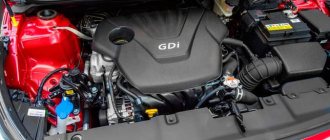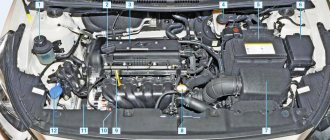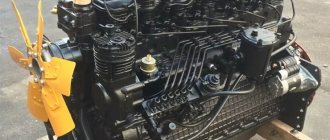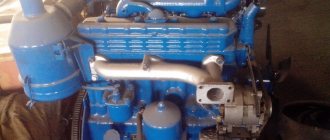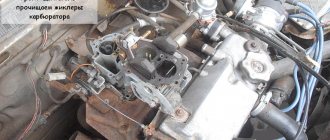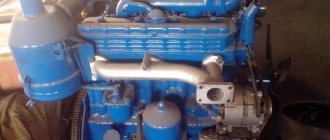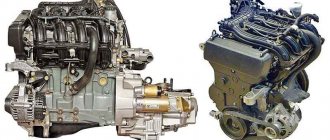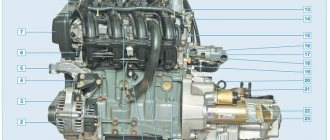To complete a fairly popular brand of car, two engines are used, the volume of which is 1.4 and 1.6 liters. The Hyundai Solaris engine is produced by the Chinese division of Hyundai. The assembly technology and control over the production process are carried out by Korean engineers, so we can confidently say that the Hyundai Solaris engine is Korean, simply produced and assembled at an external production site.
The Solaris engine is combined with a manual 6-speed gearbox or a 5-speed automatic. Both engines used to equip the car belong to the Gamma series.
G4FA
The G4FA engine is used in Solaris, Kia Rio and Kia Sid cars. This is not surprising, since the Kia car brand belongs to the Hyundai corporation. The Gamma series is the second generation of modern 1.4-1.6 liter engines, which replaced the Alpha series in 2007.
The 1.4 G4FA engine is an in-line petrol four with an overhead camshaft. The camshaft is driven by a chain drive. Classic L4 SOHC engine design. Engine capacity is 1399 cc. Maximum power 100 hp..
The engine produces a maximum torque of 13.4 Nm at 4000 rpm. The engine power curve is almost linear and depends on the speed. In city driving mode with an average mode of 3000 rpm, the engine produces about 50 hp. The maximum is reached at 6000 rpm.
The torque curve has a constant value between 2500 and 3000 rpm and the actual operating mode is located above the 12 Nm mark throughout the entire operating range.
The factory stated service life is 180,000 km.
Ideal engine for Hyundai Solaris
The base engine of the Kappa series for the new generation of Korean cars of the KIA and Hyundai brands was designed and put on the assembly line in 2015. We will talk about the latest development, a unit with G4LE coding, designed to comply with European environmental standards Euro 5. The motor is specially created for use in power plants of medium and compact models of KIA cars (Rio, Ceed JD) and Hyndai Solaris.
The injection engine with distributed fuel injection has a displacement of 1368 cm3 and a power of 100 hp. Unlike the G4FC, it has a hydraulic compensator. In addition, the phase regulators are installed on two shafts (Dual CVVT), the timing drive is advanced - with a chain instead of a belt. The use of aluminum in the manufacture of the block and cylinder head significantly reduced (up to 120 kg) the total weight of the unit.
In terms of fuel consumption, the engine brings the most modern Korean car as close as possible to the best world standards:
- in the city - 7.2 liters;
- outside the city - 4.8 l.;
- combined - 5.7 l.
G4LC has a number of interesting design features:
- The VIS system, with the help of which the geometric dimensions of the intake manifold are changed. The purpose of its use is to increase the torque.
- MPI distributed injection mechanism with injectors inside the manifold.
- Refusal to use short connecting rods in order to reduce loads on a not very powerful engine.
- The crankshaft journals are narrowed to reduce the total weight of the engine.
- In order to increase reliability, the timing chain has a plate structure.
To top it all off, Kappa engines are much cleaner than the vast majority of rivals from FIAT, Opel, Nissan, and other automakers: CO2 emissions are just 119 grams per kilometer. It weighs 82.5 kg. This is one of the best performance indicators in the world among mid-displacement engines. The main parameters of the unit (toxicity level, speed, process of formation of the fuel mixture, etc.) are controlled by a computer with an ECU consisting of two 16-bit chips.
Of course, a short service life does not give rise to the identification of characteristic malfunctions. But one “minus” still appears on various forums from owners of cars with the G4LC engine: it is noisy, compared to older lines of Hyundai units. Moreover, this applies both to the operation of the timing belt and injectors, and to the general noise level from the operation of the power plant while the vehicle is moving.
More on the topic: What kind of battery is on the Hyundai Solaris
Tired of paying fines? There is an exit!
Forget about fines from cameras! An absolutely legal new product - Traffic Police Camera Jammer, hides your license plates from the cameras that are installed in all cities.
More details at the link.
- Absolutely legal (Article 12.2);
- Hides from photo and video recording;
- Suitable for all cars;
- Works through the cigarette lighter connector;
- Does not cause interference to radios and cell phones.
G4FC
The G4FC motor is a continuation of the development of the Gamma series. Has the same block as G4FA. An increase in the volume of the combustion chamber was achieved through the use of a different crankshaft and connecting rods, which made it possible to increase the piston stroke and, accordingly, the volume. The working volume was increased to 1600 cm3. This led to an increase in power and torque, which became 111 hp. and 15.4 Nm, respectively.
The design of the engine has not changed and remains the same L4 SOHC, which implies the use of an 8-valve cylinder head. The drive is also chain, which does not require replacement during operation.
Engine life is 180,000 km. This corresponds to the maximum service life of the engine. The limitation is laid down at the design level and is determined by the resource of the cylinder block. Depending on what kind of oil is poured into the engine, you can increase or decrease the declared resource.
The most popular engine for Hyundai Solaris
Gamma engines divide this line almost in half, but still, the G4FC engine “withstood” a little more configurations. They are very similar to each other. The FC engine was “increased” in displacement from 1396 to 1591 cubic centimeters, increasing the free stroke of the piston. The year of birth of the unit is 2007. The assembly place is the Hyundai automobile plant in the capital of China, Beijing.
Inline four-cylinder fuel-injected engine producing 123 hp. designed to meet Euro 4 and 5 environmental standards. Fuel consumption (for the option with a manual transmission):
- in the city - 8.0 l.;
- outside the city - 5.4 liters;
- combined - 6.4 l.
The motor has a number of design features characteristic of modern Korean engines:
- distributed injection of the MPI type (multipoint multi point injection);
- the cylinder block and head are made of light and durable aluminum alloy;
- plastic intake manifold;
- two camshafts (DOHC);
- chain drive with tensioner in the timing mechanism.
Unlike many other modern designs, in the G4FC the designers installed the valve timing control on only one shaft, the intake.
Of particular interest is the multipoint distributed injection system installed in the engine. It has five main structural elements:
- Throttle valve.
- Ramp (main) for fuel distribution.
- Injectors (nozzles).
- Air consumption (or pressure/temperature) sensor.
- Fuel regulator.
The operating principle of the system is quite simple. The air passes through the atmospheric filter, mass flow sensor and throttle valve into the intake manifold and engine cylinder passages. Fuel comes to the injectors through a ramp. The proximity of the intake manifold and injectors minimizes gasoline losses.
Control is carried out using the computer. The computer calculates the mass fractions and quality of the fuel mixture based on load, temperature, engine operating conditions and vehicle speed. The result is electromagnetic pulses for opening and closing the injectors, supplied at a certain moment from the control unit.
MPI injection can operate in three modes:
- simultaneously;
- in pairs;
- individually.
More on the topic: Hyundai Solaris: Recharging the battery - Battery - Maintenance ||
How to charge a Solaris battery The advantages of this fuel injection scheme include efficiency and full compliance with environmental standards. But those who prefer to buy a car with an MPI engine should forget about dashing high-speed driving. Such engines are much more modest in terms of power than those in which the operation of the fuel system is organized according to the principle of direct supply.
Another “minus” is the complexity and high cost of the equipment. However, in terms of the ratio of all parameters (ease of use, comfort, cost, power level, maintainability), this system is optimal for domestic motorists.
For the G4FC, Hyundai has set a fairly low mileage threshold - 180 thousand km (10 years of operational use). In real conditions, this figure is much higher. Various sources provide information that Hyundai Solaris taxis cover up to 700 thousand km. mileage A relative disadvantage of this engine is the lack of hydraulic compensators as part of the timing mechanism, and the need to adjust the valve clearances.
Overall, the G4FC proved to be an excellent motor: light in weight, inexpensive to maintain and unpretentious. However, it is worth considering that from the point of view of major repairs, this is a one-time item. All that can be done on it is plasma spraying of cylinders and boring to the nominal size. However, is it necessary to think about what to do with an engine that can easily “travel” half a million kilometers is a rhetorical question.
Judging by the factory resource, the engine life is short. But, with proper care, you can extend the life of this unit for quite a long time without any problems. Even if you do not plan to use the car all this time, proper operation will reduce the risk of breakdowns.
The most important job to maintain engine health in adequate condition is changing the oil. Always use high quality lubricants recommended by the manufacturer. Also take into account the climatic conditions of operation. The oil must be appropriate for the season, otherwise you may end up with engine problems. It is also important to replace oil and air filters promptly. This is done simultaneously with pouring new oil.
You should only refuel at proven gas stations. This will guarantee the quality of the fuel, which in turn extends the life of the engine.
Do not constantly run the engine at high speeds. Operation of the power unit in conditions close to the limit leads to increased wear of parts and premature failure of the engine.
More on the topic: Solaris, which battery to choose: help, recommendations
Conclusion. The service life of the power unit of any machine depends on the technical characteristics and operating features. The service life of the Hyundai Solaris 1.6 engine is relatively short, but with proper use of the car it can be significantly extended.
Oil system
Oil for Hyundai Solaris is used on semi-synthetic and synthetic bases. The volume of the oil system is 3.3 liters, but when replacing, 3 liters must be poured into the engine. This is explained by the presence of an unselectable residue that remains on the walls of the lines and surfaces of the CPG. To determine which oil to pour into the engine, you must refer to the owner's manual.
Which oil to pour based on viscosity indices is influenced by climatic operating conditions, driving mode, and operating load. It is almost impossible to formulate an answer to the question - which engine oil is best for use in a particular car.
If the engine often spins up to maximum speed, or the car is used in mountainous areas, which means frequent long climbs, then it is better to use synthetic motor oils with increased protective characteristics and viscosity 0w50 or 5w50.
For normal urban use, the use of synthetics 5 w30 or 10w30 is sufficient. Although, according to its decisions, the engine can operate normally on semi-synthetic oil. The use of mineral lubricants is not permitted.
WHAT CARS CAN THE G4LC ENGINE BE PUT INTO?
KIA
| Rio FB | 2016 - present |
| Stonic | 2017 - present |
| Ceed J.D. | 2015 — 2018 |
| Ceed 3 | 2018 - present |
HYUNDAI
| Solaris HC | 2017 - present |
| i20 GB | 2015 - present |
| i30 GD | 2015 - present |
| i30 PD | 2017 - present |
Engine maintenance
It is recommended to carry out maintenance of power units every 15,000 km. The actual operating time before engine maintenance is determined by operating conditions. When using a vehicle in very dusty conditions, heavy operation, including mountain serpentines, operation of the vehicle with frequent full load requires reducing the service interval by half.
During standard maintenance, the oil and oil filter, as well as the incoming air filter, are changed. The chain does not change, since its resource is comparable to the total operating life of the internal combustion engine. The spark plugs have a service life of 30,000 km, and the fuel filter needs to be changed every 60,000 km.
The design of the power unit does not provide for the installation of hydraulic compensators, so every 90,000 km the Hyundai Solaris valves need to be adjusted. Adjusting valves is a rather complex technological process, so it is better to entrust this work to the technicians of a certified service center.
Motor selection
First of all, you need to decide on the choice of Hyundai Solaris engine characteristics. It is necessary to find differences between the available power units. Engine volumes are achieved due to the increased stroke of the piston together with the crankshaft, which are almost identical to each other. The noise level, reliability, durability and maintainability do not depend in any way on the characteristics of the pistons.
The difference between the two gasoline engines, regardless of volume, is their low fuel consumption, which largely depends on driving style. The 1.6-liter engine is significantly more powerful than its predecessor, the 1.4, which is not as peppy and does not give the confidence on the road that it could have. Let us remind you that the service life of the Hyundai Solaris 1.4 engine is 180 thousand km, and often it can work out much more.
Solaris engine repair
Major overhaul of the Solaris engine is not provided. Cast iron sleeves fused into an aluminum block are quite thin and do not require any additional mechanical processing. The block boring is not included structurally.
In addition, the manufacturer does not supply repair sizes for pistons and rings, implying that after their service life is reached, it is necessary to purchase a so-called short block, i.e. cylinder block with crankshaft and mounted CPG elements. As an option for repairing a “disposable” block, you can use plasma spraying of the material followed by boring to the nominal size.
Such repairs can restore the service life of the engines. The repairs carried out using this technology showed good results, and not only the cylinder walls, but also the crankshaft journals were restored.
Main faults of the Hyundai Gamma series
The most common problem is a noise or knocking noise caused by the chain. But this manifestation of the malfunction goes away when the engine warms up. If the knocking does not go away, then the valves should be adjusted, since incorrectly set gaps are the second cause of the knocking.
The Gamma series is very picky about the quality of the supplied air. Dirty throttle valves can affect the stable operation of engines at idle. In addition, contamination can affect the stability of speed when driving.
Another malfunction is a whistle. But this sound is not a manifestation of a motor malfunction, but indicates wear of the tensioner roller bearing; after replacing the roller, the noise disappears.
Malfunctions often include vibration that appears around the engine operating mode of 3000 rpm. Bench tests of the motor show the absence of such vibration. This manifestation is associated with the frequency characteristics of the engine-body system, which enters a resonant state at these crankshaft rotation frequencies. Increasing or decreasing speed while driving eliminates this annoying feature of the car.
